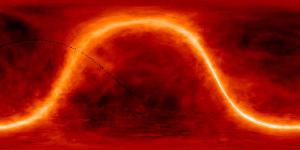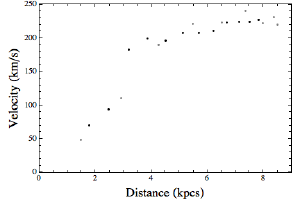Post
21 Centimeters
27 June 2012
 NRAO
NRAOHydrogen is the most common element in the universe, so when you see gas and dust around our galaxy, chances are there is a lot of hydrogen there as well. We can use that fact to map our galaxy.
It turns out that neutral hydrogen can give off radio signals at a very specific wavelength, known as the 21 cm line. The 21 cm line has two very nice properties. First, there isn’t really anything else that produces that radio frequency, so if you observe 21 cm radio waves you know it is from neutral atomic hydrogen. Second, this particular wavelength isn’t absorbed much by other clouds of gas, so it is less likely to be blocked (unlike visible light). So if you point a radio telescope in a particular direction, the more intense the 21 cm signal you detect, the more neutral hydrogen there is in that direction.
 Brian Koberlein
Brian KoberleinSince the 21 cm line is so precise, you can also see the effect of any Doppler motion, which would shift the wavelength by a bit. So when you measure the signal in a particular direction, you can measure the speed at which the hydrogen gas is moving. With a little math you can then determine the speed of gas in the Milky Way as a function of its distance from the center of the galaxy. In the figure I’ve plotted some speed vs. distance data which was collected by undergraduate students with a small radio telescope.
The distance scale goes from galactic center out to about 8.5 kiloparsecs, which is the distance of our Sun. You’ll notice the speed keeps going up as you move outward, which is a bit strange. Given the distribution of gas an dust in the galaxy, we would expect it to level off and start slowing down. Since it doesn’t, that means something strange is going on.
Of course we now know that strangeness is due to dark matter, but that’s another story.